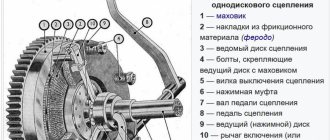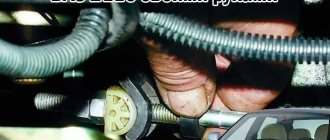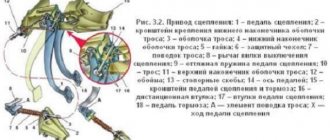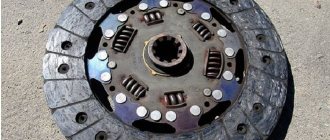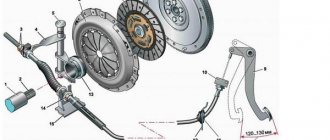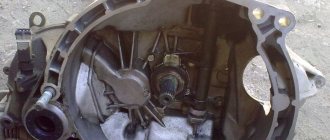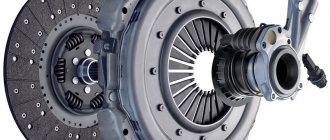Having purchased or are planning to purchase a personal car, we diligently learn the rules of the road in order to obtain a driver’s license and become, as we think, a full-fledged driver. At the same time, not everyone and does not always remember the rules for operating a car, in particular, its main component – the chassis.
Meanwhile, this area is fraught with many mysteries and secrets. For example, how not to burn out the clutch when moving away and performing this or that maneuver on the road. First of all, let’s understand at least superficially what it is and what functions this unit performs on the car.
How to use the clutch correctly
Having purchased or are planning to purchase a personal car, we diligently learn the rules of the road in order to obtain a driver’s license and become, as we think, a full-fledged driver.
At the same time, not everyone and does not always remember the rules for operating a car, in particular, its main component – the chassis. Meanwhile, this area is fraught with many mysteries and secrets. For example, how not to burn out the clutch when moving away and performing this or that maneuver on the road.
First of all, let’s understand at least superficially what it is and what functions this unit performs on the car.
How to learn to release the clutch smoothly
In order to learn to feel when the car starts moving, you need to practice the following simple technique without adding gas.
1. Engage first gear 2. Press the clutch 3. Release the clutch without adding gas. A correctly adjusted clutch begins to connect at 60-70% of its total speed.
Oh yeah.
You need to learn to feel this clutch connection point. 4. After the car seems to “strain”
and starts to move away, you need
to hold the clutch in this position for 1-2 seconds
. Since the car starts moving without adding gas, it is a load for it and a short time is needed for the engine idle speed to be restored to the set speed, and for the car itself to get a little movement.
5. After the car has moved a little, you can then smoothly release the clutch until it is fully engaged.
As soon as you learn how to release the clutch correctly, you will gain the initial skills of starting and feel the moment of starting, which will facilitate further learning to drive a car.
How does the clutch work? General concepts
The clutch consists of a disc and its pressing part, which are located in the basket. This disk is connected to the gearbox. When the clutch pedal is released, the pressure portion presses the clutch disc against the flywheel, which is connected to the engine crankshaft. The flywheel is considered the driving clutch disc, which is constantly rotated by the engine. When the clutch pedal is pressed (depressed)
the clamping part disconnects the clutch disc from the flywheel.
The driver uses the clutch pedal to adjust the connection of the disc to the flywheel. At the moment of initial connection of the clutch disc, it partially slips. , all engine speeds are not fully transmitted
to it .
There is such a thing as burning or burning a clutch.
.
While the clutch disc is slipping, it heats up and if the engine speed is high, the clutch will become very hot. Due to intense heat, the disc may crack and fly apart
.
Also, if the drive wheels slip strongly, the disc can slip and become very hot. All-wheel drive vehicles are especially prone to this. Therefore, on such cars it is forbidden to start with slipping
, as the clutch will burn. This is due to the fact that all-wheel drive cars are connected to the engine with all their wheels and the force of the pressure plate is not enough to prevent the clutch disc from slipping.
A lot can be said and written about how to learn to release the clutch smoothly. The most important thing here is the ability to feel the initial connection, and without practice it is impossible to achieve it. Once you learn how to properly release the clutch over time, you will do it automatically without thinking.
What is clutch
The clutch serves to disconnect the crankshaft and gearbox for a short time, as well as for their subsequent connection. This operation is necessary when starting a car and to change speed while driving.
The most common on cars and most trucks is a single-plate friction type clutch.
It consists directly of the clutch mechanism and the release drive.
Critical wear of the disc is easy to determine when driving in fourth gear: if, when you press the gas pedal intensely, the engine roars, but the car does not run faster, the disc needs to be changed. This may be accompanied by a burning smell.
The greatest and most common threat to the linings on the clutch disc from inexperienced motorists occurs when the car starts moving. Therefore, we will consider this process in detail.
Braking on a car with ABS
In a car without ABS, all 4 wheels lock when braking. ABS works in such a way that when braking, the wheels are blocked only for a short time, thanks to a sensor. As soon as he “realizes” that a wheel is blocked, he immediately sends an impulse to the solenoid valve of the hydraulic unit. As a result, the brake fluid pressure decreases or stops and the wheel rotates freely again.
The ABC system allows you to apply impulse braking without driver intervention. Therefore, there will be one simple rule: if the need arises for a quick stop, you just need to press the brake pedal all the way. Smart electronics will do the rest itself.
When off-road, you need to be guided by the situation: sometimes it is better to turn off ABS. For example, on a sandy slope, where it is important that the wheels are constantly blocked. Therefore, the driver needs to constantly assess the situation and not rely blindly on electronics.
How to get moving correctly
So, your engine is started and running in neutral. You depress the clutch pedal and engage first gear. Now you need to smoothly connect the crankshaft to the gearbox. This means that you need to press the driven disk against the flywheel rotating at a speed of 20-25 revolutions per second. To prevent the car from “jumping” and the engine suddenly stalling, we will perform this operation in three stages.
- Stage 1. Release the clutch pedal slightly. The pressure plate springs will bring the driven disk into light contact with the flywheel - your car will move and slowly begin to crawl.
- Stage 2. Hold the pedal in this position for two to three seconds. The rotation speeds of the flywheel and disk are gradually equalized - your car accelerates.
- Stage 3. The car drives confidently on the road - the torque is 100% transmitted to the gearbox. Release the pedal and remove your foot from it. A further half-engaged state of the clutch will burn the discs .
At the traffic light
According to numerous testimonies of novice drivers, some driving instructors teach to wait for a green traffic light with the clutch depressed and first gear engaged. It would seem that the discs do not touch, there is no threat of the linings burning. But in this case, the release bearing wears out. In the end, this negatively affects the engine in general. Therefore, put it in neutral and release the clutch pedal.
In a traffic jam
Perhaps the greatest threat to traction comes from driving in traffic jams. Some drivers do not take their foot off the clutch pedal for a long time, turning it on and off, leaving the engine in first gear.
The driven disk almost constantly rubs against the flywheel disk, and asynchronously. As a result, additional heating occurs, which contributes to more intense abrasion.
Try to move in traffic jams, covering short distances in stages, turning off the gear in between and releasing the clutch.
On the descent
On steep descents, you cannot turn off the gear. It is recommended to descend at first speed with braking using the foot brake, and be prepared, as a last resort, to use the hand brake. There is no need to use the clutch pedal. Moreover, it may pose a risk of engine stalling.
Braking in various situations
Braking behavior depends on many factors. All possible nuances are outlined below.
| Situation | Braking method | Unacceptable actions |
| Direct road or area, service stop or parking lot | With the clutch engaged, if necessary - using engine braking | Drive in neutral or with the clutch disengaged |
| Emergency on a dry road | Pulse braking with force reduction | Press the brake pedal to the floor and hold it there |
| Emergency situation on a wet or slippery road | Impulse braking with increasing force | Hit the brake pedal hard and steer while braking. |
| Driving on a steep slope | Engine braking in a low gear, helping the car with short presses on the brake pedal (if necessary) | Use only the brake pedal, brake for a long time |
| Cornering | Reduce speed in advance, do not disengage the clutch when turning | Brake sharply, especially by holding the brake pedal for a long time |
We tried to analyze all braking options. But, if you are a beginner and want to drive your car safely, then it is best to contact an experienced instructor and practice all the above options for braking on a manual transmission.
Riding in extreme conditions
Driving with slippage truly “kills” the clutch, which often happens in unforeseen, extraordinary conditions. When we happen to get out of a puddle or a snowdrift, we are forced to speed up the engine, giving it high speeds and sharply engage the clutch.
In this situation, not only the linings on the disk burn fatally. Such harsh operating conditions also threaten more serious damage, including to other vehicle components. Therefore, if possible, ask to be taken in tow. Don't burn the clutch.
Why does it burn
It is at the moment of incomplete contact with each other of the disks rotating at different speeds that the linings burn out. Whenever we operate the clutch incorrectly, the gap gradually increases, and subsequently the squeeze becomes incomplete - the clutch begins to slip. The disk needs to be changed.
It's OK. After all, this is an ordinary consumable part for your car, designed for approximately 80,000 km if used correctly.
Source
How to use the clutch correctly - how it works, how to depress the clutch and release the pedal
How to drive a car correctly and how to press the control pedals correctly is taught in driving schools, but it happens that even many years of driving experience do not teach you to take care of the clutch in the car - it simply wears out quickly and requires replacement (and without a clutch, until it is replace the car, it won’t be able to drive)
In order to understand how to properly use a car clutch, you need to have a good idea of how it works and the purpose of individual components, for example, the pressure plate, which motorists have long dubbed the “basket.”
Whether or not to depress the clutch when braking in manual mode
Different driving schools explain it differently: some say that you need to squeeze, others insist that you need to use the clutch pedal only when the car has almost stopped, so as not to stall. We will say this: you need to brake according to the situation, since the way the clutch works depends on weather conditions and the condition of the road surface.
What is a car clutch
Structurally, the clutch (friction clutch) in a car is designed to connect and disconnect the engine shaft with an automatic or manual transmission.
This allows you to move away without sudden jerks and ensures smooth gear shifting on the move, preventing overload of the transmission components due to changes in the crankshaft speed.
There are different drive designs for transmitting force from the pedal to the pressing mechanisms, such as mechanical, hydraulic and electric.
What not to do with a manual transmission
A manual transmission is a reliable type of transmission, but improper operation can significantly reduce its service life and lead to significant damage.
What not to do with a manual transmission:
- engage reverse gear until the car comes to a complete stop (manual transmission failure);
- depress the clutch except for the moments necessary to change gears (increased wear of the release bearing and clutch occurs);
- keep your foot on the clutch pedal while driving (leads to increased wear on the clutch);
- select a high gear (3,4,5) when the speed and low revs are insufficient for this (increased load on the engine and gearbox);
- When stopping for more than 40 seconds, depress the clutch; select neutral gear (increased clutch wear);
- change gears without squeezing the clutch (manual transmission failure);
- constantly keep your hand on the gearshift lever (increased wear of various gearbox mechanisms);
- incomplete clutch release when changing gears;
- dropping the clutch.
If you follow some rules and drive thoughtfully, the experience of driving a car with a manual transmission will come quickly, despite the apparent complexity of such a transmission.
The main advantage of a car with a manual transmission is complete control over it, which is realized only after driving kilometers.
Automatic car
In the automatic version, the clutch occurs according to the “wet” type using transmission oil enclosed in a torque converter and two impellers. The flywheel blades carry with them a flow of oil, which spins the pump wheel - this is how rotation is transmitted in an automatic transmission (automatic transmission)
Such an automatic car does not have a clutch pedal, so in general the driving process itself will be simpler and easier (there are especially many fans of automatic transmission among women).
Car with manual transmission
Photo: clutch pedal - left side
In a car, the clutch pedal is located in the leftmost position of the three pedals - the pedal in the center is the brake, the pedal on the right side is the gas, the left pedal is the clutch - and with its help the driver controls the connection of the engine to the gearbox.
Manual operation requires more attention compared to automatic, but for many users this is a matter of habit and a matter of price.
A car with an automatic transmission will be much more expensive to purchase and maintain, which is why many drivers choose cars with manual controls that have a clutch pedal.
Correct use of the clutch pedal
It will be useful for a beginner to learn how experienced motorists use a car clutch correctly and how the clutch works.
By applying simple recommendations in everyday driving, a beginner will achieve mastery much faster if he learns to change gears correctly and engage the desired speed, reducing the load on the tires and brake discs.
This applies to such driving moments as short stops, for example, at traffic lights and on turns.
How to properly depress the clutch
In essence, the correct use of a friction clutch involves the precise execution of two interrelated operations - the pedal must be pressed and then released.
Simple tips will tell you how to properly squeeze the clutch:
The pedal is pressed all the way and without delay. Since the main thing is experience, it is better not to waste time on training, finding a suitable platform for this and hiring an experienced driver for the company.
At the very beginning of training, shoes are important - to make the sensations more pronounced, they should have thin soles and no heels.
How to release the clutch correctly
By releasing pressure on the pedal, the driver begins to connect the engine flywheel and the driven disk to transmit rotation to the gearbox.
This must be done very carefully and smoothly - there are several recommendations for novice car enthusiasts on how to release the clutch so that the ride is as comfortable as possible:
The pedal should not be depressed for a long time; the pedal should be gradually released without sudden thrusts, pausing slightly when it is pressed halfway.
The car must start moving from first gear. You can start from second gear only in winter, when the road or some sections of the road are very slippery (if you start on slippery ground in first gear, the wheels will slip and it will be difficult to move at all).
Video: How to properly use the clutch in a car
Video: How to properly release the clutch and operate the pedals in a car
Source
What happens to the car when the clutch is depressed
Clutch is a mechanism involved in transmitting torque from the engine to the gearbox and then to the wheels of the car. It is necessary for smooth gear shifting, to start or stop the car. In other moments of movement, the clutch is not needed.
If such a situation nevertheless occurs, then the torque transmission is broken. This can lead to poor vehicle control or, worse, skidding.
The most dangerous moments for braking with the clutch disengaged:
- descent movement;
- driving on wet or icy road surfaces;
- driving on asphalt covered with debris or sand.
If you decide to brake with the clutch engaged, the torque will be transmitted evenly to all drive wheels. In such cases, the car is more stable, the load on the brakes becomes less, and stopping occurs smoothly.
Tip 1: How to learn to drive a manual transmission
Learning to drive a manual transmission seems impossible for many novice drivers. However, the ability to cope with the “mechanics” is the basis of the fundamentals of driving skills. Let's look at the most popular misconceptions and mistakes that prevent you from learning how to drive a car competently.
Instructions
- It's difficult to get started with a manual transmission. It's difficult to get started only because you don't feel the car well yet. The beginning of a movement is a combination of several actions that must be performed sequentially. The legs cannot yet work synchronously to push/pull the pedals. Hence the constant jerking at the start. Don't ignore the tachometer readings. Correctly dialed speed will allow you to start and drive smoothly.
- I don’t know how to change gears While driving, you need to change gears to increase speed. Many people do not know at what point it is necessary to switch to increased or decreased speed. Each gear corresponds to a speed segment. The first speed is needed to start moving or to move very slowly, for example, in a traffic jam. After starting to move, you need to accelerate a little and immediately switch to second. Then watch the instrument panel. When the needle starts to approach 30-40 km/h, switch to third. After 50 km/h, engage fourth gear. Engaging fifth gear on different cars can vary from 80 to 100 km/h.
- It’s easier to drive with an automatic transmission. It’s really easier to drive a car with an automatic transmission. The period of learning and adaptation on the road is noticeably reduced. It’s safer to drive in traffic jams with an automatic, because your legs rest. But winter driving in such a car can be greatly complicated by weather conditions. It is easier to get a car with a manual transmission out of an uncontrolled skid or drift. Because you can operate the clutch and brake with the engine. And if you get stuck in a snowdrift, it is much more difficult to rock a car with an automatic transmission.
- Manual transmission provides more opportunities for confident driving. Fans of manual transmission consider its most important advantage to be the maximum opportunity to drive the car independently. You can choose the required speed for acceleration yourself, without waiting for the system to switch itself. Manual transmission provides more opportunities for fast, dynamic driving. It’s not just that all racing cars are equipped with “mechanics”. And most importantly, if you understand the manual transmission, you will no longer be afraid of any problems. Life is different, and sometimes you have to, contrary to your wishes or in the current situation, get behind the wheel with a manual transmission. And if a person has never done this, then he will have a very, very difficult time on the road.
Driving capabilities with correct clutch pedal operation
Once you figure out at what point the clutch engages, you will need to achieve a smooth ride when starting off.
With proper operation of the clutch pedal, you can achieve:
- the most minimal speed,
- when parking or reversing, in order to have time to turn the steering wheel in the right direction,
- during other maneuvers requiring minimum speed, both forward and reverse
To achieve a minimum driving speed, practice taking off on a straight section and immediately pressing the clutch. After pressing the clutch pedal, your car will coast and, without touching the gas pedal, try to slowly release the clutch, the car will begin to slow down, the so-called engine braking, and press the clutch pedal again. And you can do this as much as you like until you stop completely.
Just try not to make the engine jerk, so to speak, “coughing.” The engine must run smoothly. This is how you can use the clutch to reduce the speed to a minimum. You can drive without even pressing the gas pedal or with minimal gas supply.
As soon as you begin to catch this moment when the car starts moving, or feel the load on the engine by sound - this is the moment the engine’s work is transferred to the rotation of the wheels, then everything else is a matter of technology.
The clutch mechanism experiences stress almost all the time during vehicle operation. It depends on the road conditions, how loaded the car is, how you learn to control the clutch when changing gears and starting, and driving in general.
Learn to change gears in a timely manner, according to road conditions.
First of all, you don’t need to “gas” too much when starting from a stop, but “gas” only to support the engine’s operation.
THESE ACTIONS SHOULD BE POSTED IN YOUR HEAD AND FURTHER IN YOUR HANDS AND LEGS.
Practice thoroughly to catch this clutch moment.
Tip 2: How to learn to drive manually
Learning to drive a car with a manual transmission is more difficult than learning to drive a car with an automatic transmission. But, if you practice long enough, this science is given to everyone. You can master mechanics either with the help of a qualified instructor or on your own.
Instructions
- Sit comfortably in the seat and adjust it to suit you. Adjust the rear view mirrors. If possible, lower the windows to better hear the sound of the engine. Look at the pedals. In all cars, the left pedal is the clutch, the middle pedal is the brake, and the right pedal is the gas. Fully depress the clutch. Adjusting your seat should allow you to do this without difficulty.
- The manual transmission lever is located in the center of the cabin between the front seats. On the knob there is a diagram of the gears. Remember it. Make sure the gearbox lever is in neutral. To do this, pull the lever left and right. If it walks freely, it means the speed is in neutral.
- Depress the clutch and start the engine. Remember this and get into the habit of starting the engine with the clutch depressed. Then engage first gear according to the diagram. Most often, to do this, you need to move the lever to the left and up. Then begin to smoothly and slowly release the clutch until the engine runs noticeably quieter.
- As soon as the engine speed drops, remember this moment for yourself. It is very important in order to learn how to get started on the mechanics. In order for the car to move at this very moment, you should begin to smoothly press the gas while continuing to release the clutch. If you release the clutch too quickly or too slowly, the car may stall.
- After you learn how to start, learn to change gears while moving. At approximately 3000-4000 engine rpm, release the gas pedal and simultaneously press the clutch. While the car is coasting, engage second gear and smoothly release the clutch. Then apply gas. Do not keep your foot on the clutch pedal all the time. Place it on the special platform to the left of the pedal.
- If you need to stop, take your foot off the gas pedal and press the brake. As soon as the speed drops to 10-20 km/h, depress the clutch and shift to neutral. Subsequently, train yourself to brake with the clutch depressed or in neutral.
Note!
When starting off and while driving, never look at the pedals. Always look forward.
Helpful advice
If you have an assistant, let him support you in the first stages of training. In case of any danger, he must quickly brake the car with the handbrake, and before that he must constantly be on alert.
Main types of braking
Standard braking
This type of braking occurs in the event of a planned stop of the vehicle. This could be stopping at a traffic light in order to park or let a car or pedestrian pass.
This approach allows you to maintain the desired trajectory, and, if necessary, quickly gain speed.
Engine braking
This type of braking is acceptable, most often on long descents. In such a situation, the driver takes his foot off the gas pedal, thereby stopping the flow of fuel and reducing engine thrust. Smooth braking occurs, without stress on the braking system.
Stepped combined braking
The essence of such braking is to periodically press the brake pedal over a short period of time. The force of pressing the pedal depends on the situation:
- on snowy, icy road surfaces or off-road, a stepped braking method is used with increasing force;
- on dry asphalt or concrete, a stepwise method with decreasing force is used.
Emergency braking and steering
It is best to use the pulse (step) method of braking during emergency braking. If necessary and if the situation allows, you can gradually switch to lower gears.
Taxiing is performed during periods when the brake pedal is released. The steering movements are so short, impulsive, without intercepting the hands. With this approach, the trajectory will be more predictable and there will be less risk that the car will go into an uncontrolled skid.
It is PROHIBITED to lean forward and hold tightly to the steering wheel in an emergency situation . It is best to rest your back against the back of the car seat. With this arrangement, you will better feel the behavior of the car and the beginning of a skid.
Tip 3: How to learn to drive a car
Studying at a driving school is the basics, and perfection comes with kilometers behind the wheel. At a driving school you will only be given a theoretical and practical knowledge base, which will be very difficult for you during your first days on the road. Improving your skills should be done with an experienced person who can point out mistakes and teach you how to perform elements and technical nuances.
- Get on the road every day. Until you have muscle memory, you need to rack up as many driving hours as possible. It could even be circling around a deserted parking lot or leisurely driving along a country road. Your goal is to get used to the car, to bring acceleration and braking to automaticity, a straight trajectory, and to get used to the dimensions of the car.
- Get rid of psychological pressures and fears. Your uncertainty gives rise to mistakes and dissatisfaction of other participants in the movement. Place a “Student Driving” sign (exclamation mark in a yellow square) on your rear window. For other drivers, this will be a sign that there is no need to make sudden maneuvers and lane changes in front of you, or to honk in response to your slowness. If at any point you feel like you are losing control of the situation, turn on your hazard lights and pull to the side of the road. Take a break, think and hit the road with renewed vigor.
- Learn to predict the actions of traffic participants. You should always be in control of everything that happens around your vehicle. You must calculate the cars ahead two ahead. If a truck is driving in front of you and is blocking your view, overtake it or change lanes. Otherwise, a situation is possible when the car in front suddenly changes lanes in front of an obstacle that has arisen, and you will not have time to do this.
- Students say that the most difficult thing is working with a manual transmission and changing lanes in heavy traffic. Mastering the “mechanics” takes more time, but you will also get more pleasure from driving. Plus, manual transmission is more convenient and safer in winter. Changing lanes in heavy traffic requires the driver to have a sense of speed and distance. You need to learn how to accelerate to the speed of the flow, maintain it and change lanes at a safe distance.
Tip 4: How to learn to drive a car
Getting started is the most difficult part of learning to drive a car. But it’s rarely possible to achieve a smooth ride the first time. If you understand the principle and learn to feel the operation of the engine, then it turns out there is nothing complicated about it. Instructions
- Getting moving in a car with a manual transmission is the very first element that students begin to perform in a driving school. And really, there is no other way. But this is where the first problems begin - the car jerks, hums and stalls. But if you do everything correctly and consistently, you yourself will stop noticing how you got on.
- On a car with a manual transmission, to start driving, you need to depress the clutch, engage first gear, and, while depressing the clutch pedal, press the gas pedal. It doesn't seem complicated. Now let’s look at all the errors in detail.
- When you start pressing the gas pedal, the clutch pedal must be released smoothly. What happens is that the clutch pedal continues to be held, accelerating and increasing the speed, or it is abruptly released without starting to move and the engine stalls.
- Monitor the tachometer operation. You can start by accelerating a little, keeping an eye on the needle. You need to understand at what tachometer value there is enough revolutions for the car to move.
- The clutch and gas pedals must be depressed simultaneously, with the same force. If you suddenly feel that the clutch has been depressed too much, press the pedal again. Your main task is to move off smoothly and not stall. You don't need to gas it a lot. If you give a lot of gas, then the clutch pedal should be released very quickly. And you will start slipping.
- You need to not miss the moment when the required speed is reached, the car will begin to make a jerk. Lower the clutch almost all the way. But hold it a little until the car moves a couple of meters. And only then can you release the clutch completely.
- A simple exercise will help you understand where you can release the clutch pedal. Turn on first speed. Do not press the gas pedal. Begin to slowly release the clutch pedal. At a certain moment, the car will move smoothly and slowly. And you need to remember at what point in the clutch pedal position the car starts moving.
The design and principle of operation of the clutch pedal
1 — release bearing guide sleeve; 2 — gearbox input shaft; 3 — cable lead; 4 — clutch release fork; 5 — fork axle bushing; 6 — pressure disk assembly (basket); 7 — driven disk; 8 - flywheel; 9 — clutch pedal ; 10, 11, 12 — mechanism for automatic adjustment of cable length; 13 — release bearing; 14 — clutch cable; 15 — cable stop
What happens when we press the clutch pedal.
We press the clutch pedal (9), at this moment the clutch cable (14) is tensioned, which moves the clutch release fork (4), the fork rotates on the axle bushing (5). The fork presses on the release bearing (13), which in turn presses the paddles in the clutch basket (6), and the paddles are connected directly to the pressure plate, which is located inside the basket. The basket is bolted to the flywheel (8), and the flywheel is rigidly connected to the engine crankshaft and always rotates when the engine is running. The pressure plate presses the driven disk (7) against the flywheel. The driven disk is located between the basket and the flywheel on the splines of the input shaft of the gearbox (2) and when the clutch pedal is released, the driven disk is clamped, thereby ensuring the clutch of the engine with the gearbox, and then with the entire chassis. When the clutch pedal is pressed, the drive disc releases the driven disc (7) and the engine's traction with the wheels is released.
Clutch actuation moment
Perhaps it will immediately become clear to you at what exact moment, when releasing the clutch pedal, the load on the engine occurs, and in order to get the car moving, we must try to hold the clutch pedal and prevent the engine from stalling. And to increase the traction force of the engine, we press the gas pedal.
It will be necessary to achieve slipping of the clutch discs by operating the pedal - which leads to a smooth transition of engine speed to the wheels.
But this is not enough - you need to firmly grasp the moment of coupling. You can't do this without training.
When we begin to release the clutch pedal, during the slightest actuation of the clutch we will immediately press the pedal again.
When you release the clutch pedal, approximately until the middle of its stroke, the pedal goes to idle, therefore, before the clutch is activated, the pedal can be released faster. In the future, you will, unnoticed by yourself, skip the idling pedal. The idle speed is designed to give you time to set up for work.
The clutch process itself occurs within an interval of no more than one to two centimeters of pedal travel. But you will need to directly capture the moment the clutch operates.
Repeat this procedure several times to figure out in what position the clutch starts to engage, preventing the engine from stalling.
Try not to strain your leg too much, but rather try to feel the process at the level of anticipation. When starting off, try to press the clutch pedal again and again in order to quickly grasp this moment and let your foot get used to it.
If you do not allow the clutch to fully engage with the pedal, the car will begin to move smoothly.
At the same time, without releasing the clutch pedal, but rather even pressing it a little, slipping of the discs should prevent rapid acceleration, but should not lead to a stop.
This is interesting: How to tighten the Daewoo Matiz alternator belt
Tip 5: How to learn to drive a manual car
The majority of Russian car enthusiasts are owners of cars with a manual gearbox (MT). Most driving schools teach driving on just such vehicles. Therefore, the problem arises of how to learn to drive a car with a manual transmission.
- The first step is to understand the box system. A manual transmission usually has 5 steps, which are numbered. Gear changes occur while pressing the clutch pedal. Therefore, first you need to learn how to change gears correctly and on time. Without starting the car, you need to get behind the wheel and for one hour methodically change gears according to the following scheme: “clutch - gear - clutch - next gear” and so on until the last step. We must not forget that while changing gears you must keep the clutch pedal depressed, otherwise you will not be able to shift.
- The next step is to learn to understand when to change gear while driving. The signal for switching is engine speed. Either by sound or by the tachometer it is necessary to monitor the engine speed. Experienced drivers determine the moment of switching from a lower to a higher gear only by sound. The smaller the engine displacement, the faster the switching point occurs. If the speed needs to be reduced, then at the right moment, when the speed is below the tachometer readings, you need to switch the box to a lower gear. Otherwise, the gearbox will experience increased wear.
- Once a novice driver understands the basics of shifting gears, he needs to make the gear shifting process automatic. The best time for this is on weekends, when the roads are clearer and while driving it is possible to both slow down and accelerate using a manual gearbox. Traffic jams can also be useful for this, when the driver needs to quickly change the lowest gears.
Helpful advice
All manual transmissions have a neutral position. Unlike other gears, driving on it is impossible. But if you put it in neutral and release the clutch pedal, the engine will not stall. This is very useful when driving in urban conditions, when you have to stand at traffic lights and in traffic jams, relieving stress from your legs.
Source
Preparing for the start
But before you set off and drive anywhere at all, you must first prepare the car for movement in accordance with the requirements of the traffic rules.
To do this, at a minimum, it is necessary to check the serviceability of the light alarm, the adjustment of the rear-view mirrors, the operation of the windshield wipers, warm up the engine, etc.
We will assume that this process has been completed, the engine is warmed up, and the tire pressure is normal. The car is parked on a level surface.
What needs to be done as soon as you get behind the wheel? The correct answer is to fasten your seat belt (this can be done later, but you must have it fastened when you start driving).
Our next action will be to start the engine. To do this, depress the clutch (if the car is equipped with an automatic transmission, make sure that the gear shift lever is in the “P”-park position) and turn the key in the ignition switch. Start the engine.
While we’re not going anywhere, you can release the clutch pedal. Now you are ready to get moving.

